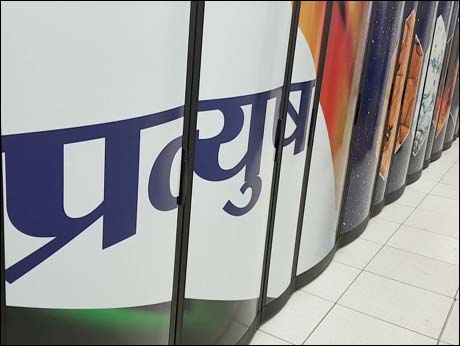
November 14 2018: India's presence in the global Top 500 fastest supercomputers released on November 13, remains unchanged since the last rankings six months ago.
The Indian Institute of Tropical Meteorology's Cray XC 40- LC named Pratyush, remains the fastest high performance computer based in India, clocking 3.7639 peta flops, though it has slipped 6 places in the global rankings from no. 39 to no. 45.
The second-fastest India-based platform at no. 73 remains the same -- another Cray XC 40 at National Centre for Medium Range Weather Forecasting clocking 2.5704 peta flops.
Next at no 338, comes a supercomputer from Lenovo the 1.123 peta flop C 1040, used by the company for its research in India.
Bringing up the rear as far as supercomputers in India are concerned, that make this half-year's Top 500, at no 486, is yet another XC40, the sub-peta flop (901 teraflop) system at the Supercomputer Education and Research Centre (SERC) of the Indian Institute of Science, Bangalore.
This only underlines what seems to be the current thrust of India's supercomputing programme whose mantra seems to be "Why make when we can buy?"
Indeed, the two fastest machines at IITM and NCMRWF, were acquired after India dusted and re-launched its National Supercomputing Mission in 2015 with a Rs 45 billion ( Rs 4500 crore) kitty with its current stated objective of initially buying 6 supercomputers and gradually assembling them in India. An indigenously developed supercomputer is now relegated to the third phase of the 7-year programme. This has created very good business for US supercomputer makers like Cray, who made some of their biggest sales last year, to India.
The current thrust of the government's supercomputing plans are a far cry from the 1980s, when India entered the club of high performance computer (HPC) developers with the Param series of indigenous machines designed and developed by the Centre for Development of Advanced Computing ( C-DAC). Iterations of Param figured in the Top 500 lists for many years -- but in the last decade, the series has not kept pace with the global march to peta flop and --soon -- exaflop systems.
Other government departments which had active supercomputing programmes like Atomic Energy (Anupam), DRDO ( ANURAG), CSIR/NAL (Flosolver) and briefly C-DIT are not known to have significantly grown beyond their own internal requirements.
This only reinforces the impression that India's national priorities in supercomputing are today seeing a subtle shift from build to buy.
For the world's 5 fastest supercomputers in Top 500, read here